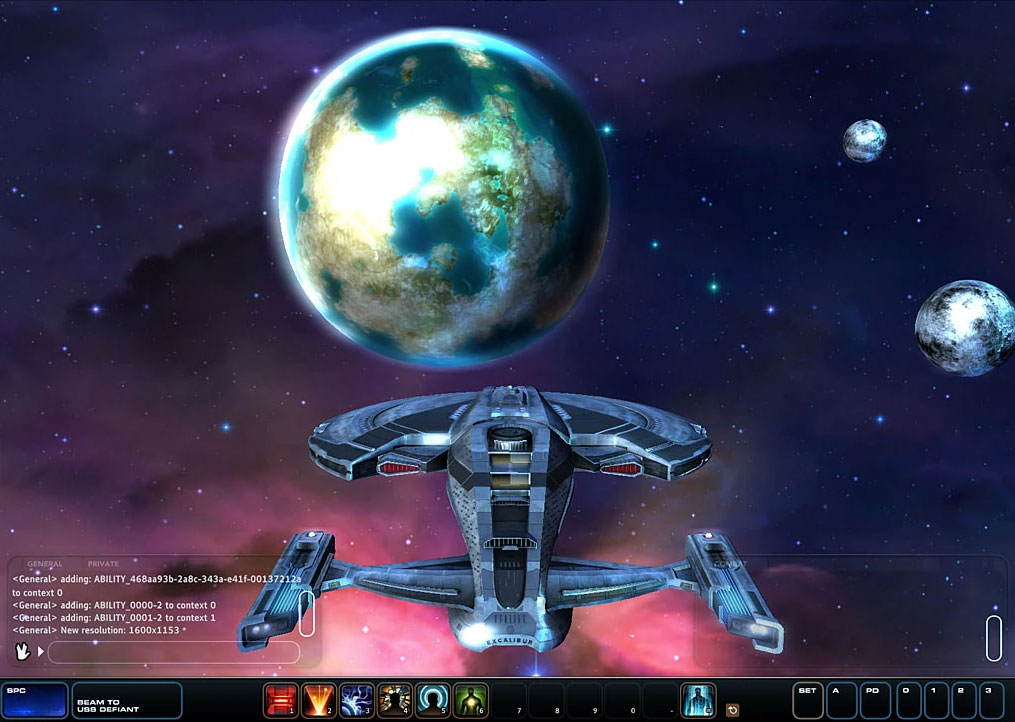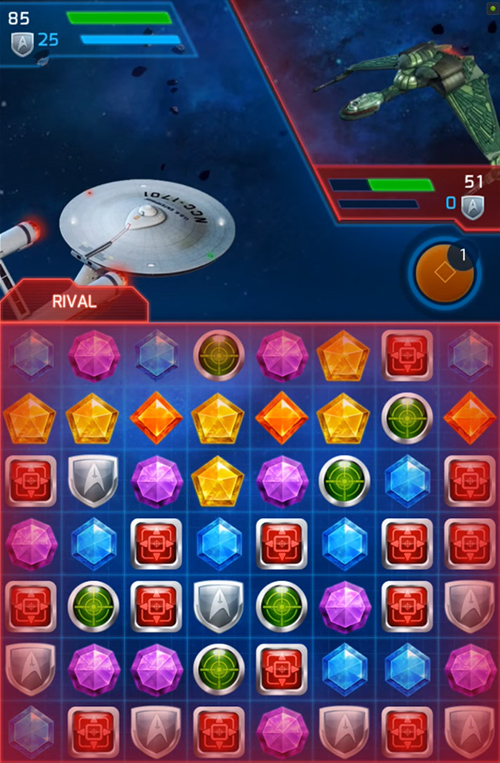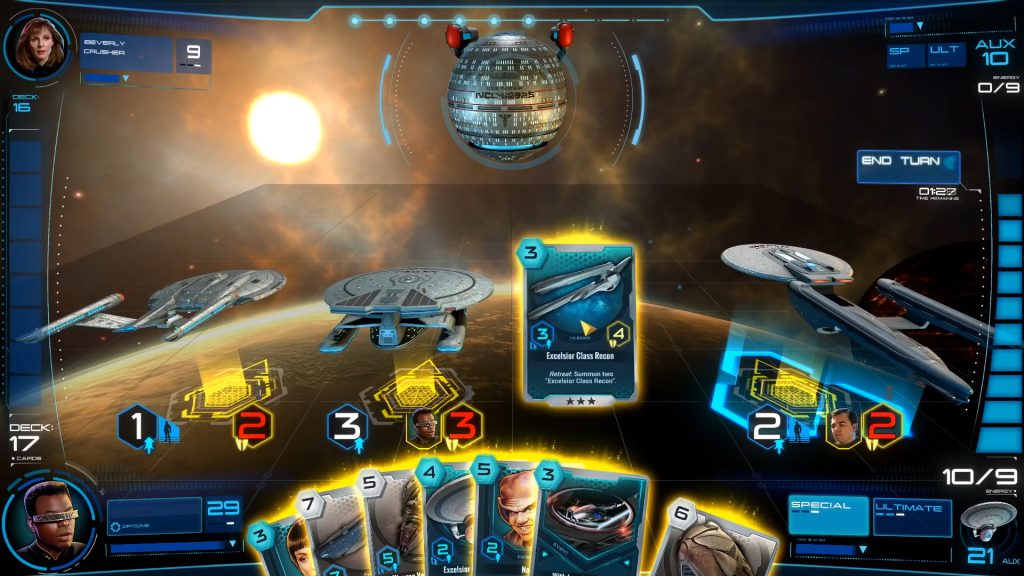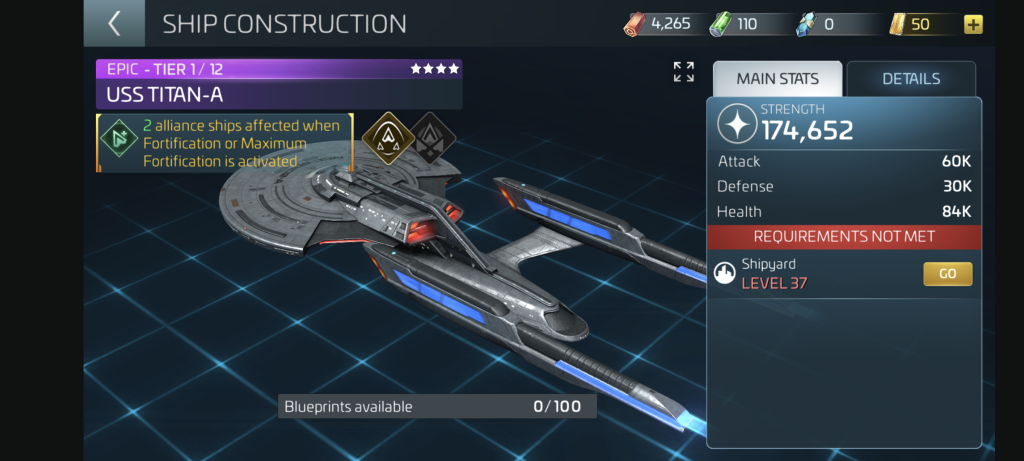Star Trek: Encounters

This is a sort of tie in game to Star Trek Legacy for the PlayStation 2 – a cheap game thrown at the older generation console while all the effort was focused on the Xbox 360. This game does though all the Star Trek shows, from Enterprise to Voyager, along with a campaign called “Star Trek: Sovereign” featuring the Enterprise E.
The game is an arcade twin stick shooter. Left analogue stick moves, right analogue stick shoots. While it’s a simple game, the controls are convoluted: the left shoulder buttons change height, you have to swap between phasers, torpedoes and other abilities. What should have been really easy is now a pain due to the control setup, and the change in height makes almost no difference to the game.
While a lot of the game is shooting, you’ll encounter various obstacles to padd the game such as racing through rings or following warp trails by moving between glowy things within a short time (which is far more annoying than it sounds). The missions themselves are sometimes very loosely based on stuff that happens in the show, but also really off (like the Xindi invading Earth in the Enterprise missions). Others are slightly unique, such as the Enterprise D encountering a giant lifeform and getting sucked into it.
The missions start with a short briefing from an extremely bored William Shatner, with no other voice acting (and zero actual dialogue) in the game, your next objective just pops up in generic sounding text. This couples with how ships move makes it feel like you’re playing with toy ships. Similar to how there are LEGO games, this would feel much better if it was called “Micro Machines Star Trek”.
Star Trek: Conquest

Conquest is a budget 4x strategy game that has a board game feel about it. You pick a race, build fleets, conquer systems and gain more resources to build more stuff.
The maps itself is quite small with only a few spaces between each homeworld, which means it’s quick to get into fights. On top of this, each neutral system starts off with enemies you have to fight before you can use it.
There are multiple options for the combat. You can skip straight for the results, watch the battle play out on the menu (with you being able to set offensive or defensive modes) or play the battles out in an arcade style. This is very similar to Encounters, being a twin stick shooter, but is thankfully much nicer to control. It’s fun for a little bit, but does get tiresome.
The main game has some nice ideas, and the simplicity does help it. You’re limited to three fleets to move around, and they must be in different locations. You also have superweapons that charge up to attack (or heal). Unfortunately, the game itself is not well balanced. The maps are pre-designed based around the players and races involved, and some races can have a lot more space to expand before encountering opponents. The Dominion homeworld is also very easy to defend with one route to it, including having Deep Space Nine as a strong station standing in the way.
Conquest does feel a bit like a side game from a bigger release, but for a small budget release it’s not too bad – I do think XBLA would have been an ideal platform for it.
Star Trek All About Trivia

A trivia game with many questions about The Original Series. You roll the dice and answer a question from the category you land on. If you get it correct, you take another turn.
Each player also has three “communicator” cards that allow them to skip a question and try a new one from the next card.
Once a player reaches the last space, the opposing players choose what category the player has to play.
Star Trek Online (Perpetual Entertainment)

This version of Star Trek Online was in development by Perpetual Entertainment. The game was due to a lot of focus on non-combat activities such as planetary surveys and diplomatic activities (although there would be plenty of combat, too).
Players could only own small ships to trave on their own. The bigger ships – such as the Galaxy class and Sovereign class – were large social hubs with detailed interiors where you would be a member of the crew.
The story was set 20 years after Nemesis, where the galaxy was at relative peace and even the Borg weren’t a huge threat. It was focused on exploring the Beta Quadrant and one of the main NPCs would have been Miral Paris, who influenced a lot more Klingons to join Starfleet, especially those that believe her to be the kuvah’magh (this part was kept in the Cryptic version).
Developing your character would be about specialising in certain fields, such as medical or flight control, and gain skills that would help in a variety of different situation.
There was even an ambition of Star Trek Online leading to a TV show, with player’s actions in the game impacting the show. This concept was tried again by a different Sci-Fi show, Defiance, but the “influence” ended up not amounting to much.
When this version of Star Trek Online was cancelled in 2008 (with all development staff sacked), the game’s assets were given to Cryptic Studios, who used it as a basis for their version, but ultimately decided on a different path. There was also a stipulation that the new version had to be released within two years.
Star Trek: D-A-C

D-A-C stands for “Deathmatch, Assault, Conquest”, the three game modes in this arcade ship shooter. I couldn’t get the game to run on PC, and because absolutely nobody cares about this game, couldn’t find any methods to try, so I tried the Xbox 360 version.
You play as Federation or Romulans from the Star Trek 2009 film (even though the only Romulans involved are from the future), each with three classes of ships: Fighters which play like a twin stick shooter, bombers which drop mines behind them and flagships which have crosshairs that they move across the screen to aim. The deluxe and PC versions added a few more, but they don’t change much.
The ships control light one-man fighters, and when you die you launch an escape pod (which is not much smaller than the ship itself) and if you survive, you respawn quicker. It feel like this game was designed as a new IP before having Star Trek quickly thrown on top. Other than the great title screen music (taken from the film), nothing feels remotely Star Trek.
Other than the escape pod mechanic, there’s nothing interesting about the game itself. Deathmatch is deathmatch, and Assault and Conquest are just variants of King of the Hill. The game later got a survival mode of just defeating waves of enemies.
Star Trek: The Mobile Game (Java Button)

Star Trek: The Mobile Game. It’s everything you expect a cheap java Star Trek to be: a vertical scrolling bullet hell shooter. While The Birds of Prey was a fun take on the genre, this is just mindless and dull, even though there’s so much happening on the screen.
Your ship automatically fires (you can turn this off, but then you’re just tapping a button constantly as there’s no reason not to) fighting through hoards of Klingon, Cardassian and Romulan forces. While this is set in the Kelvin timeline, all enemy designs are from the TNG era shows.
As you complete missions, you can upgrade the Enterprise to make it shoot faster or have more health. There are different power ups to collect, which work just like any other space shooter like this, with powerful screen-filling weapons.
Star Trek: The Mobile Game (Java Touch)

The version of Star Trek: The Mobile Game is similar to the version made for button phones, but does have changes. The game is much, much slower, with lots more space to move around as the view is zoomed out and the visible area is wider. It doesn’t make the game any better, just worse in every way.
Star Trek: The Mobile Game (iOS)

The version of Star Trek: The Mobile Game for iPhone is essentially a nicer looking version of the button Java version. The enemy layouts are exactly the same, as well as the pace of the game. The graphics look more 3D, with a bit more depth to everything.
Delta Vega: Meltdown on the Ice Planet

In the advertising campaign for the Star Trek 2009 movie, advertising partners were sought to promote the film. One of them was Esurance, an American insurance company. They produced a flash game starring their mascot, Erin Esurance, called Delta Vega: Meltdown on the Ice Planet.
In the game, you shot your way though five levels of enemies (which consisted of random creatures) in order to rescue Keenser from the outpost we see from the film.
Unfortunately, I can’t find the game itself, and there aren’t even many screenshots of it.
- Original Release: 2006
- Developer: 4J Studios
- Publisher: Bethesda
- Platform: PS2

This is a sort of tie in game to Star Trek Legacy for the PlayStation 2 – a cheap game thrown at the older generation console while all the effort was focused on the Xbox 360. This game does though all the Star Trek shows, from Enterprise to Voyager, along with a campaign called “Star Trek: Sovereign” featuring the Enterprise E.
The game is an arcade twin stick shooter. Left analogue stick moves, right analogue stick shoots. While it’s a simple game, the controls are convoluted: the left shoulder buttons change height, you have to swap between phasers, torpedoes and other abilities. What should have been really easy is now a pain due to the control setup, and the change in height makes almost no difference to the game.
While a lot of the game is shooting, you’ll encounter various obstacles to padd the game such as racing through rings or following warp trails by moving between glowy things within a short time (which is far more annoying than it sounds). The missions themselves are sometimes very loosely based on stuff that happens in the show, but also really off (like the Xindi invading Earth in the Enterprise missions). Others are slightly unique, such as the Enterprise D encountering a giant lifeform and getting sucked into it.
The missions start with a short briefing from an extremely bored William Shatner, with no other voice acting (and zero actual dialogue) in the game, your next objective just pops up in generic sounding text. This couples with how ships move makes it feel like you’re playing with toy ships. Similar to how there are LEGO games, this would feel much better if it was called “Micro Machines Star Trek”.
Star Trek: Conquest
- Original Release: 2007
- Developer: 4J Studios
- Publisher: Bethesda
- Platform: Wii, PS2

Conquest is a budget 4x strategy game that has a board game feel about it. You pick a race, build fleets, conquer systems and gain more resources to build more stuff.
The maps itself is quite small with only a few spaces between each homeworld, which means it’s quick to get into fights. On top of this, each neutral system starts off with enemies you have to fight before you can use it.
There are multiple options for the combat. You can skip straight for the results, watch the battle play out on the menu (with you being able to set offensive or defensive modes) or play the battles out in an arcade style. This is very similar to Encounters, being a twin stick shooter, but is thankfully much nicer to control. It’s fun for a little bit, but does get tiresome.
The main game has some nice ideas, and the simplicity does help it. You’re limited to three fleets to move around, and they must be in different locations. You also have superweapons that charge up to attack (or heal). Unfortunately, the game itself is not well balanced. The maps are pre-designed based around the players and races involved, and some races can have a lot more space to expand before encountering opponents. The Dominion homeworld is also very easy to defend with one route to it, including having Deep Space Nine as a strong station standing in the way.
Conquest does feel a bit like a side game from a bigger release, but for a small budget release it’s not too bad – I do think XBLA would have been an ideal platform for it.
Star Trek All About Trivia
- Original Release: 2007
- Developer: Fundex
- Publisher: Fundex
- Platform: Board Game
- Not played: Not enough information to recreate.

A trivia game with many questions about The Original Series. You roll the dice and answer a question from the category you land on. If you get it correct, you take another turn.
Each player also has three “communicator” cards that allow them to skip a question and try a new one from the next card.
Once a player reaches the last space, the opposing players choose what category the player has to play.
Star Trek Online (Perpetual Entertainment)
- Original Release: N/A (Cancelled 2008)
- Developer: Perpetual Entertainment
- Publisher: Perpetual Entertainment
- Original Platform: PC
- Not played: No leaked prototypes.

This version of Star Trek Online was in development by Perpetual Entertainment. The game was due to a lot of focus on non-combat activities such as planetary surveys and diplomatic activities (although there would be plenty of combat, too).
Players could only own small ships to trave on their own. The bigger ships – such as the Galaxy class and Sovereign class – were large social hubs with detailed interiors where you would be a member of the crew.
The story was set 20 years after Nemesis, where the galaxy was at relative peace and even the Borg weren’t a huge threat. It was focused on exploring the Beta Quadrant and one of the main NPCs would have been Miral Paris, who influenced a lot more Klingons to join Starfleet, especially those that believe her to be the kuvah’magh (this part was kept in the Cryptic version).
Developing your character would be about specialising in certain fields, such as medical or flight control, and gain skills that would help in a variety of different situation.
There was even an ambition of Star Trek Online leading to a TV show, with player’s actions in the game impacting the show. This concept was tried again by a different Sci-Fi show, Defiance, but the “influence” ended up not amounting to much.
When this version of Star Trek Online was cancelled in 2008 (with all development staff sacked), the game’s assets were given to Cryptic Studios, who used it as a basis for their version, but ultimately decided on a different path. There was also a stipulation that the new version had to be released within two years.
Star Trek: D-A-C
- Original Release: 2009
- Developer: Naked Sky
- Publisher: Paramount Digital
- Platform: Xbox 360, PS3, PC

D-A-C stands for “Deathmatch, Assault, Conquest”, the three game modes in this arcade ship shooter. I couldn’t get the game to run on PC, and because absolutely nobody cares about this game, couldn’t find any methods to try, so I tried the Xbox 360 version.
You play as Federation or Romulans from the Star Trek 2009 film (even though the only Romulans involved are from the future), each with three classes of ships: Fighters which play like a twin stick shooter, bombers which drop mines behind them and flagships which have crosshairs that they move across the screen to aim. The deluxe and PC versions added a few more, but they don’t change much.
The ships control light one-man fighters, and when you die you launch an escape pod (which is not much smaller than the ship itself) and if you survive, you respawn quicker. It feel like this game was designed as a new IP before having Star Trek quickly thrown on top. Other than the great title screen music (taken from the film), nothing feels remotely Star Trek.
Other than the escape pod mechanic, there’s nothing interesting about the game itself. Deathmatch is deathmatch, and Assault and Conquest are just variants of King of the Hill. The game later got a survival mode of just defeating waves of enemies.
Star Trek: The Mobile Game (Java Button)
- Original Release: 2009
- Developer: EA Mobile
- Publisher: EA
- Platform: Java (Button Phones)

Star Trek: The Mobile Game. It’s everything you expect a cheap java Star Trek to be: a vertical scrolling bullet hell shooter. While The Birds of Prey was a fun take on the genre, this is just mindless and dull, even though there’s so much happening on the screen.
Your ship automatically fires (you can turn this off, but then you’re just tapping a button constantly as there’s no reason not to) fighting through hoards of Klingon, Cardassian and Romulan forces. While this is set in the Kelvin timeline, all enemy designs are from the TNG era shows.
As you complete missions, you can upgrade the Enterprise to make it shoot faster or have more health. There are different power ups to collect, which work just like any other space shooter like this, with powerful screen-filling weapons.
Star Trek: The Mobile Game (Java Touch)
- Original Release: 2009
- Developer: EA Mobile
- Publisher: EA
- Platform: Java (Touch Phones)

The version of Star Trek: The Mobile Game is similar to the version made for button phones, but does have changes. The game is much, much slower, with lots more space to move around as the view is zoomed out and the visible area is wider. It doesn’t make the game any better, just worse in every way.
Star Trek: The Mobile Game (iOS)
- Original Release: 2009
- Developer: EA Mobile
- Publisher: EA
- Platform: iOS
- Not played: Do not own compatible device.

The version of Star Trek: The Mobile Game for iPhone is essentially a nicer looking version of the button Java version. The enemy layouts are exactly the same, as well as the pace of the game. The graphics look more 3D, with a bit more depth to everything.
Delta Vega: Meltdown on the Ice Planet
- Original Release: 2009
- Developer: Esurance
- Publisher: Esurance
- Platform: Browser
- Not played: Flash file can’t be found online.

In the advertising campaign for the Star Trek 2009 movie, advertising partners were sought to promote the film. One of them was Esurance, an American insurance company. They produced a flash game starring their mascot, Erin Esurance, called Delta Vega: Meltdown on the Ice Planet.
In the game, you shot your way though five levels of enemies (which consisted of random creatures) in order to rescue Keenser from the outpost we see from the film.
Unfortunately, I can’t find the game itself, and there aren’t even many screenshots of it.



















































